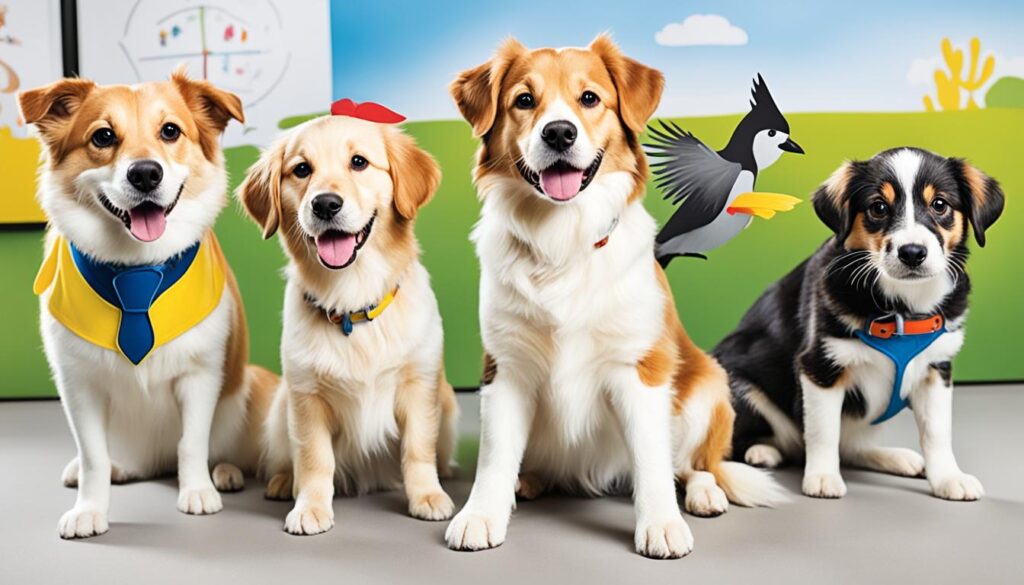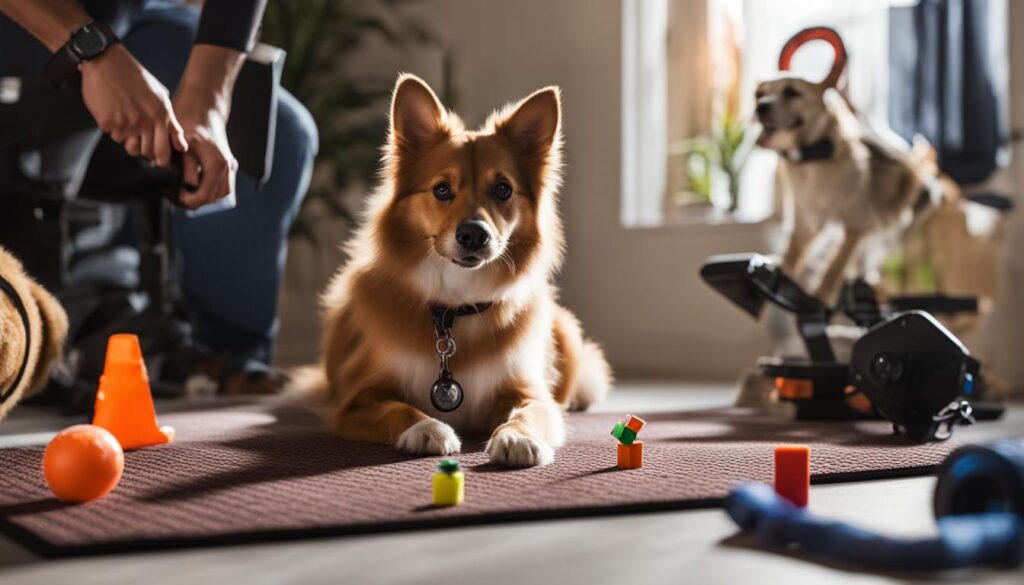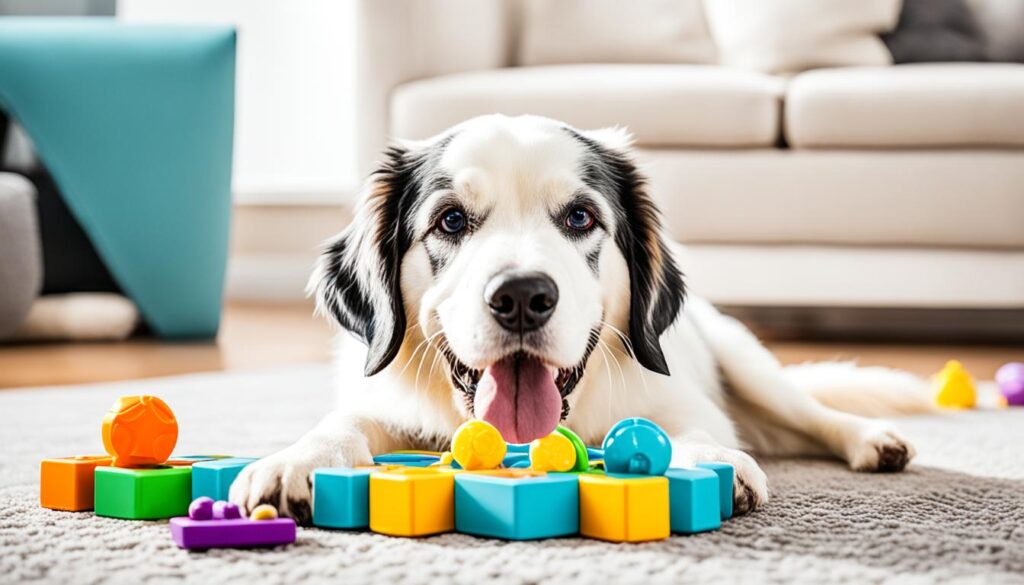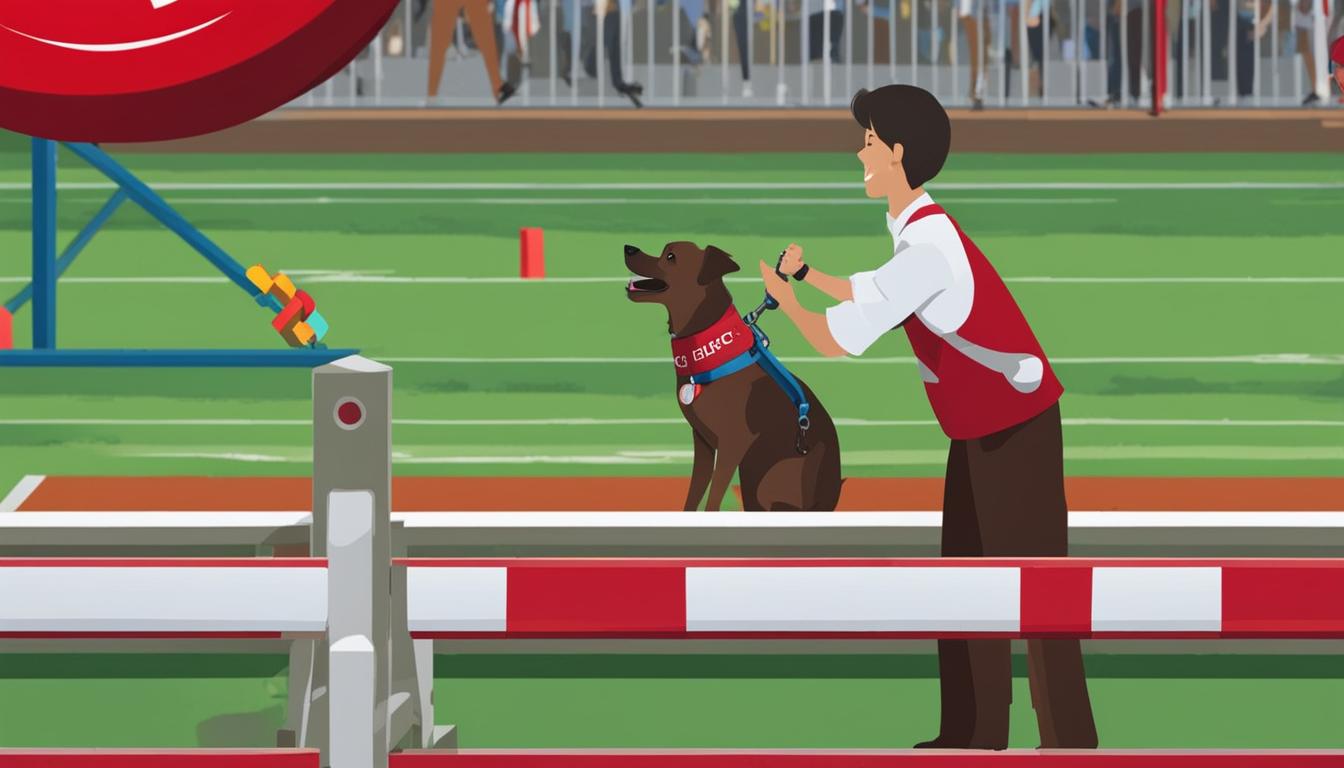Welcome to our comprehensive guide on training your pet for success! Whether you have a playful pup or a curious kitten, investing time and effort into their training will help unlock their full potential and ensure a harmonious relationship between you and your furry friend. In this guide, we will explore effective pet training techniques, tips, and products that will set you and your pet on the path to success.
Training your pet is a journey that goes beyond basic obedience commands. It involves cultivating effective communication, promoting safety through obedience training, customizing techniques to suit your pet’s unique personality, preparing them for real-world situations, maintaining consistency in training sessions, utilizing positive reinforcement, providing mental stimulation, and using the right training essentials. By covering these areas, you will be well-equipped to guide your pet towards success.
Are you ready? Let’s dive into the world of pet training and discover how you can unlock your pet’s full potential!
Key Takeaways:
- Training your pet is crucial for their success and well-being.
- Effective communication forms the foundation of pet training.
- Obedience training promotes safety and prevents accidents.
- Customize your training techniques to suit your pet’s personality and learning style.
- Train your pet to succeed in real-world situations.
The Importance of Effective Communication in Pet Training
Effective communication is vital in pet training as it helps create a strong bond and understanding between you and your pet. By establishing clear and consistent communication channels, you can ensure that your pet comprehends your expectations and instructions. This lays the foundation for a harmonious relationship built on trust and mutual cooperation.
Creating a Common Language for Better Understanding
When training your pet, it is essential to establish a common language that both of you can understand. This common language consists of verbal cues, body language, and consistent reinforcement. By using the same words or gestures consistently, your pet can associate them with specific commands or behaviors, making it easier for them to understand and respond appropriately.
Consistency is key in creating a common language. Use the same words or phrases to command your pet during training sessions and everyday interactions. For instance, if you want your dog to sit, consistently use the command “sit” instead of using different variations like “sit down” or “take a seat.” This clarity and consistency will enhance your pet’s understanding and make training more effective.
Using Commands to Build a Harmonious Relationship
Training commands play a crucial role in building a harmonious relationship with your pet. These commands serve as cues for your pet to perform specific actions or behaviors. By teaching them basic commands such as “sit,” “stay,” “come,” and “leave it,” you can establish boundaries and expectations, promoting obedience and a well-behaved pet.
When using commands, it is important to be clear and assertive. Use a firm yet gentle tone to convey your instructions. Additionally, pair the verbal command with appropriate hand signals or gestures, especially if you are training a deaf pet or one that responds well to visual cues.
Remember to reward your pet for correctly following commands. Positive reinforcement, such as praise, treats, or playtime, can strengthen the bond between you and your pet and motivate them to continue obeying commands. This positive association with training commands contributes to a harmonious relationship based on trust and reward.
By prioritizing effective communication, creating a common language, and using clear commands, you can lay the foundation for a harmonious relationship and successful pet training.
Promoting Safety Through Obedience Training
Obedience training is crucial when it comes to ensuring the safety of your beloved pet. By teaching them important commands and promoting good behavior, obedience training creates a secure and well-behaved pet that can help prevent accidents and ensure their well-being.
Through obedience training, your pet will learn commands such as “sit,” “stay,” “come,” and “leave it,” which are essential for their safety in various situations. These commands can prevent them from running into oncoming traffic, approaching dangerous objects or substances, or engaging in behavior that could harm themselves or others.
Training your pet to follow these commands can be a lifesaver in emergency situations or when potential dangers arise. By promoting safety through obedience training, you are equipping your pet with the skills they need to navigate the world confidently and securely.
Additionally, obedience training provides mental and physical stimulation for your pet, helping them to be more well-behaved and content. Dogs, for instance, thrive on structure and discipline, and obedience training provides them with a sense of purpose and fulfillment.
Customizing Training Techniques for Every Pet’s Personality
Every pet is unique, and their individuality extends to their learning style and personality. It’s crucial to understand these nuances when it comes to training your pet effectively. By customizing training techniques and tailoring your approach to their specific needs, you can optimize their success in learning and achieving desired behaviors.
Assessing Individual Learning Styles
Just like humans, pets have different learning styles. Some may respond better to visual cues, while others may prefer hands-on activities. By observing your pet’s behavior and paying attention to their responses during training sessions, you can identify their preferred learning style. This allows you to adapt your training methods to cater to their unique way of understanding and retain new information.
Personalizing Your Approach for Optimal Success
A personalized approach to pet training is essential for optimal success. It involves understanding your pet’s personality traits, preferences, and motivation factors. By recognizing their likes, dislikes, and what motivates them, you can tailor your training techniques to maximize their engagement and willingness to learn. This customized approach ensures that your pet feels understood, valued, and supported throughout the training process, leading to better results.

Training Your Pet for Success in Real-World Situations
Training your pet to succeed in real-world situations is essential for their overall well-being. As responsible pet owners, it is important to prepare our furry friends to navigate everyday scenarios with confidence and obedience. Whether it’s encountering other animals, walking on a leash, or behaving appropriately in public, proper training ensures a harmonious interaction between your pet and their surrounding environment.
At XYZ Pet Training, we understand the significance of real-life training scenarios. Our expert trainers have developed proven techniques to help your pet thrive in various situations, promoting their safety, socialization, and good behavior.
“Real-life training scenarios provide valuable opportunities for your pet to learn and adjust their behavior to different environments and stimuli.” – XYZ Pet Training
Here are some essential tips and techniques for training your pet to succeed in real-world situations:
- Socialization: Introduce your pet to different animals, people, and environments to build their confidence and reduce anxiety in unfamiliar situations.
- Leash Training: Teach your pet to walk calmly on a leash, following basic commands such as “heel” and “stay,” to ensure a pleasant and controlled walk.
- Public Etiquette: Implement training exercises that focus on proper behavior in public, such as sitting calmly, not jumping on people, and staying attentive to their handler.
- Distraction Training: Gradually expose your pet to various distractions, such as loud noises or tempting objects, and reinforce their ability to stay focused and obedient.
By incorporating these real-life training techniques into your pet’s routine, you can equip them with the skills needed to handle unpredictable situations with confidence and success.
Remember, consistent training and positive reinforcement are key to achieving desired results. Whether you are teaching your pet to greet new friends or navigate a busy park, patience, practice, and praise go a long way in shaping their behavior.
At XYZ Pet Training, we are committed to helping you and your pet build a strong foundation of training. Our tailored approach prioritizes real-life scenarios to ensure your pet’s success in any environment. Contact us today to start your pet’s journey towards a lifetime of positive and fulfilling experiences.
The Role of Consistency in Effective Pet Training
In pet training, consistency is key to achieving successful results. Consistency establishes clear expectations and helps your pet understand what is expected of them. Regular training sessions are crucial for reinforcing desired behaviors, shaping new ones, and creating a strong bond between you and your furry friend.
How Regular Training Sessions Benefit Your Pet
Regular training sessions provide numerous benefits for your pet:
- Improved Learning: Consistently practicing commands and behaviors helps your pet learn and retain them more effectively.
- Enhanced Progress: Regular training sessions ensure steady progress in their training journey, allowing them to master more advanced skills over time.
- Increased Confidence: Consistent training builds your pet’s confidence and helps them feel secure and comfortable in various situations.
- Better Communication: Regular training fosters clearer communication between you and your pet, enhancing your ability to understand and respond to each other’s cues.
- Strengthened Bond: Consistency in training builds trust, strengthens the bond between you and your pet, and reinforces your role as their reliable leader.

Maintaining Training Discipline and Routines
Training discipline and routines are essential components of consistent pet training:
- Set a Schedule: Establish a regular training schedule that works for both you and your pet. Consistency in timing will help your pet anticipate and prepare for training sessions.
- Be Firm and Consistent: Set clear rules and boundaries for your pet and consistently reinforce them. Consistency in expectations and consequences will help your pet understand and meet your training standards.
- Repetition is Key: Repeat training exercises consistently to reinforce behaviors and create lasting habits for your pet.
- Stay Patient and Persistent: Consistency requires patience and persistence. Training discipline and routines may take time and effort, but the rewards are more than worth it.
By maintaining training discipline and routines, you create an environment that supports your pet’s learning, growth, and overall well-being.
Consistency in pet training is essential for achieving desired results. Regular training sessions benefit your pet’s learning and progress, while maintaining training discipline and routines fosters effective communication and reinforces desired behaviors. By embracing consistency in your pet training journey, you are laying the foundation for a harmonious and successful pet-owner relationship.
The Benefits of Positive Reinforcement in Pet Behavior Training
Positive reinforcement is a powerful tool in pet behavior training. By employing techniques that focus on motivating and rewarding your pet, you can achieve better behavior outcomes and strengthen the bond between you and your furry friend.
Using positive reinforcement involves providing your pet with praise, treats, or other rewards when they exhibit desired behaviors. This method encourages your pet to repeat those behaviors in order to receive the positive reinforcement again.
Here are some key benefits of incorporating positive reinforcement in your pet’s training:
- Effective and gentle: Positive reinforcement is a humane and effective approach to training that avoids the use of harsh punishment or aversive techniques. It promotes a positive learning experience for your pet and helps build trust and confidence.
- Motivates learning: By associating desired behaviors with rewards, positive reinforcement motivates your pet to learn and engage in training sessions. It creates a positive and enjoyable environment that stimulates their interest and encourages them to actively participate in the learning process.
- Strengthens the bond: When you reward your pet for their good behavior, it reinforces the bond between you. Your pet will associate you with positive experiences and view you as a source of trust, love, and rewards.
- Encourages desirable behaviors: Positive reinforcement focuses on reinforcing desirable behaviors, such as sitting, staying, or coming when called. By consistently rewarding these behaviors, you can increase the likelihood of your pet exhibiting them in various situations and environments.
- Reduces unwanted behaviors: Through positive reinforcement, you can effectively redirect your pet’s attention and discourage unwanted behaviors. By reinforcing alternative desirable behaviors, you can help your pet understand what behaviors are preferred and desired.
To incorporate positive reinforcement into your pet’s training, it is important to identify what motivates your pet, whether it be treats, praise, toys, or a combination of these rewards. Consistency and timing are also crucial, ensuring that you provide the reward immediately after your pet exhibits the desired behavior.
Remember, positive reinforcement creates a positive and fulfilling training experience for both you and your pet. It not only helps shape their behavior but also strengthens the bond and trust between you, leading to a harmonious and fulfilling pet-owner relationship.
Mental Stimulation and Its Effects on Pet Well-being
Mental stimulation is essential for a well-rounded and happy pet. Interactive play not only provides physical exercise but also engages your pet’s mind, preventing boredom and destructive behavior. By incorporating interactive play into your pet’s training routine, you can enhance their overall well-being and strengthen your bond.

Interactive Play as a Training Tool
Interactive play serves as an effective training tool for pets. It allows them to learn new skills, reinforce obedience commands, and improve their problem-solving abilities. Through interactive play, you can make training sessions fun and engaging, motivating your pet to actively participate and learn.
Preventing Destructive Behavior Through Mental Exercise
One of the primary benefits of mental stimulation is its ability to prevent destructive behavior in pets. Engaging your pet’s mind and providing outlets for their energy through interactive play can redirect their focus away from destructive behaviors such as chewing, scratching, or excessive barking. When your pet’s mental and physical needs are met, they are less likely to engage in undesirable behaviors, leading to a harmonious home environment.
Training Essentials: The Must-Have Products to Guide Your Pet
Having the right training tools and products is essential for successful pet training. The right treats and tools can make a significant difference in your pet’s learning and progress. In this section, we will provide guidance on selecting the right treats and tools for training, as well as highlight the importance of using appropriate training aids.
Selecting the Right Treats and Tools for Training
When it comes to training your pet, selecting the right treats is crucial. Treats act as a powerful motivator and reward during training sessions. It’s essential to choose treats that are not only delicious but also healthy for your pet. Consider their dietary restrictions, preferences, and any allergies they may have.
Look for treats that are specifically designed for training purposes. These treats are usually small in size, making them easy to handle and quick to consume. They should also be soft and easily breakable, enabling you to reward your pet frequently without overfeeding them or interrupting the flow of the training session.
As for training tools, invest in high-quality items that facilitate effective communication and control. Some essential training tools include:
- Clickers: Clickers are a popular tool used in positive reinforcement training. They help mark and reinforce desired behaviors effectively.
- Training Leashes: Training leashes provide better control and enable you to guide your pet during walks and training sessions.
- Target Sticks: Target sticks are useful for teaching precise movements and target-based commands.
- Treat Pouches: Treat pouches allow for easy access to treats during training sessions, ensuring convenience and efficiency.
Remember, the right treats and tools should align with your training goals and your pet’s needs. Take the time to research and choose wisely to enhance the effectiveness of your training sessions.
Highlighting the Importance of Appropriate Training Aids
In addition to selecting the right treats and tools, using appropriate training aids is essential for successful pet training. Training aids are designed to assist you in achieving specific training objectives and addressing common behavioral challenges. They can include:
- Training Clickers: Clickers are excellent training aids that help establish clear communication and reinforce positive behaviors.
- Barking Control Devices: Barking control devices, such as anti-bark collars or deterrent sprays, can be used to manage excessive barking and promote peace in the neighborhood.
- Potty Training Tools: Potty training aids, like indoor/outdoor pet toilets or training sprays, can be helpful in teaching your pet where to eliminate.
- Training Treat Pouches: Treat pouches provide a convenient way to carry treats during training sessions, keeping them readily accessible for rewarding good behavior.
When using training aids, it’s essential to follow the instructions provided and use them responsibly. Remember that training aids should complement your positive reinforcement techniques and never be used as a substitute for proper training.
By selecting the right treats and tools, and using appropriate training aids, you can set your pet up for success in their training journey. These essential elements will help you establish effective communication, reinforce positive behaviors, and achieve your desired training goals.

Conclusion
In conclusion, training your pet is a rewarding journey that unleashes their full potential for success. By understanding the importance of effective communication, promoting safety through obedience training, customizing techniques for your pet’s personality, training for real-world situations, maintaining consistency, utilizing positive reinforcement, providing mental stimulation, and using the right training essentials, you can ensure a harmonious and successful pet-owner relationship.
Remember, consistent training and clear communication are key to building a strong bond with your pet. Obedience training promotes safety and helps prevent accidents, while customized techniques cater to your pet’s individual learning style for optimal success. Training your pet to navigate real-world situations helps them thrive in various environments.
Utilizing positive reinforcement techniques and providing mental stimulation not only improve your pet’s behavior but also enhance their overall well-being. By using the right products and tools, you can guide your pet effectively and achieve desirable results. Following these expert tips and techniques will enable you to unlock your pet’s true potential and create a fulfilling pet-owner relationship.
FAQ
What is the importance of effective communication in pet training?
Effective communication is vital in pet training as it helps create a strong bond and understanding between you and your pet. It allows you to create a common language with your pet and use clear training commands to convey expectations, which contributes to a harmonious relationship.
How does obedience training promote safety for your pet?
Obedience training plays a crucial role in ensuring the safety of your pet. It can prevent accidents, teach important commands for safety, and promote a secure and well-behaved pet.
How can training techniques be customized for a pet’s personality?
Every pet has a unique personality and learning style. It is important to assess your pet’s individual learning style and tailor your training approach to their specific needs. Customizing the techniques for your pet’s personality leads to optimal success in training.
How can you train your pet to succeed in real-world situations?
Training your pet for success in real-world situations is essential for their overall well-being. You can train them to navigate everyday scenarios such as meeting other animals, walking on a leash, and behaving appropriately in public.
What role does consistency play in effective pet training?
Consistency is key in pet training. Regular training sessions benefit your pet’s learning and progress, and maintaining training discipline and routines reinforces their training habits.
What are the benefits of positive reinforcement in pet behavior training?
Positive reinforcement is a powerful tool in pet behavior training. It motivates and rewards your pet, leading to better behavior and a stronger bond between you and your furry friend.
How does mental stimulation affect pet well-being?
Mental stimulation is crucial for a well-rounded pet. Interactive play can be used as a training tool to engage your pet’s mind and prevent destructive behavior, ultimately enhancing their overall well-being.
What are some must-have training products for your pet?
Having the right training tools and products is essential for successful pet training. You should focus on selecting the right treats and tools for training and using appropriate training aids.
What are some final tips for successful pet training?
Training your pet is a journey that unlocks their full potential for success. Follow these expert tips, such as effective communication, obedience training, customization, real-world training, consistency, positive reinforcement, mental stimulation, and using the right training essentials, to ensure a harmonious and successful pet-owner relationship.
Source Links
- https://www.dogtopia.com/blog/unleashing-potential-the-importance-of-dog-training/
- https://medium.com/@DailyPets_14/unleashing-success-a-comprehensive-guide-to-training-your-dog-8de34f1ab9f4
- https://miamivalleyk9.com/the-value-of-in-person-dog-training-unleashing-your-pets-full-potential/

